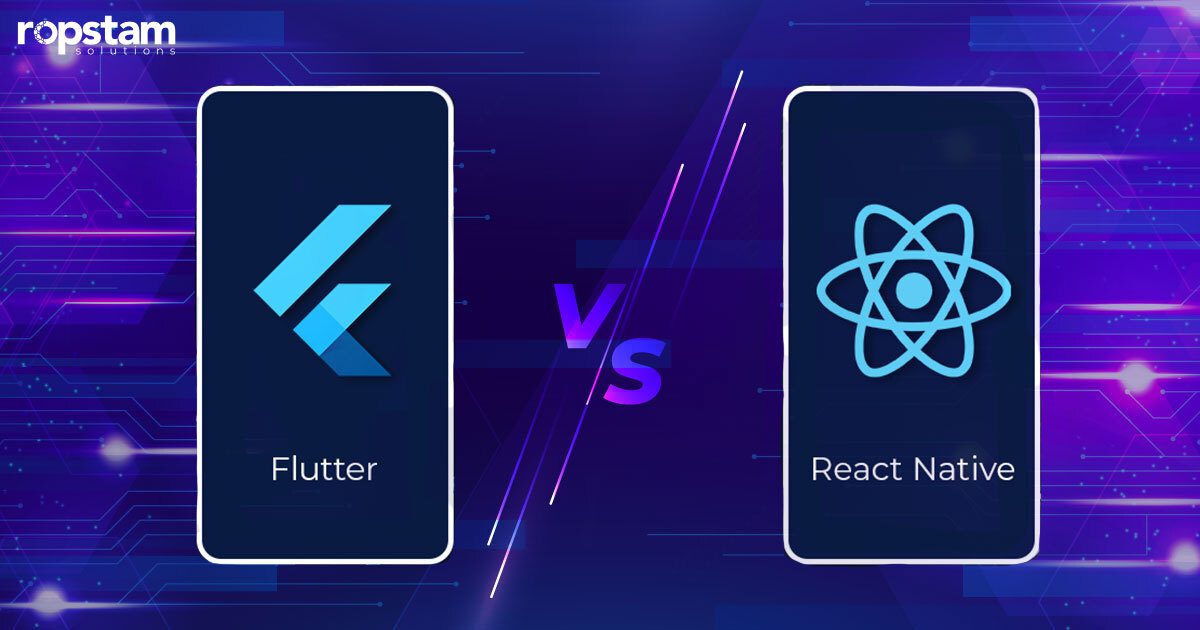With the popularity of smartphones at an all-time high, every business is looking for the opportunity to target mobile phone users. To conquer the mobile development landscape, cross-platform frameworks have gained immense popularity in recent years. Indubitably, Flutter and React Native have become the front-runners in this field for creating efficient, multi-platform mobile applications,
But what makes these two frameworks stand out from the rest? This article will dig deep into the Flutter vs React Native debate, delineating the pros and cons along with the use cases of both.
Flutter vs React Native – Factor-wise comparison for making right decision
Now that you know the basics of both Flutter and React Native, it’s time to expand this debate by performing a comprehensive, in-depth analysis of both frameworks:
In 2017, Google shook up mobile development by introducing Flutter, an open-source UI toolkit for building natively compiled, high-performance apps for multiple platforms from a single codebase.
| Factors | Flutter | React Native |
| Performance | Flutter’s compiled code and widgets result in excellent performance. Animations run at 60fps. 🥇 Winner | React Native provides good performance, but animations can be slower at 30-40fps. |
| Speed | Hot reload provides lightning-fast previews. 🥇 Winner | Live reloading is slower, and the JS bridge can cause stuttering. |
| Documentation | Flutter has excellent documentation with free tutorials and sample codes. 🥇 Winner | React Native has decent docs and resources but is not as comprehensive. |
| Community Support | Flutter has an active, growing community. | Given that React is older, it has massive community support. 🥇 Winner |
| 3D Support | Boasts a Flutter Engine for built-in 3D rendering. 🥇 Winner | Provides only basic 3D support. |
| Language | Uses Dart language developed by Google. | Based on JavaScript. |
| Learning Curve | Significantly easier to learn. 🥇 Winner | Steeper learning curve. |
1) Performance:
Flutter emerges as the winner in performance, with its compiled code and widget-based architecture ensuring smooth and responsive animations consistently at 60 frames per second. React Native, while offering good performance, sometimes lags with animations running between 30 to 40 fps, marking Flutter as the clear frontrunner in this category.
2) Speed:
Flutter’s hot reload feature significantly outpaces React Native, earning it the winner’s title for development speed. It provides instant previews of changes without losing the state, ensuring a swift and efficient development process.
On the other hand, React Native’s live reloading is comparatively slower, and the JavaScript bridge may introduce noticeable stuttering, affecting the overall speed.
3) Documentation:
Flutter boasts superior documentation, complete with a plethora of free tutorials and sample codes, positioning it as the winner in this area. This comprehensive support accelerates development and learning.
On the other hand, while React Native’s documentation is ample and helpful, it doesn’t quite reach the breadth and depth that Flutter offers to its developers. It is fair to claim that React Native’s documentation lacks the level of depth offered by Flutter. Consequently, it lags behind Flutter in this regard.
4) Community support:
While Flutter has an active and rapidly expanding community, React Native claims victory in community support due to its longevity. Being older, understandably, React Native has amassed a vast and experienced community, providing an invaluable resource for developers seeking assistance and sharing knowledge.
5) 3D support:
Flutter’s built-in engine provides robust 3D rendering capabilities, making it the winner in this regard. It allows for the creation of intricate and visually striking 3D interfaces. On the contrary, React Native offers basic 3D support, which, while functional, does not match the advanced 3D capabilities provided by Flutter.
6) Language:
Flutter utilizes Dart, a modern language developed by Google, optimized for building user interfaces, and known for its scalability. React Native, on the other hand, is based on the widely used and versatile JavaScript, making it familiar to a broader range of developers. Hence, one can say that both frameworks have a solid foundation when it comes to their respective programming languages.
7) Learning curve:
Flutter takes the lead here as well for having a more accessible learning curve, thanks to its cohesive and well-structured framework. Developers can grasp its concepts more quickly, leading to a smoother learning experience. Meanwhile, React Native presents a steeper learning curve, potentially requiring more time to achieve proficiency due to its reliance on bridging native modules.
What is Flutter?
In 2017, Google shook up mobile development by introducing Flutter, an open-source UI toolkit for building natively compiled, high-performance apps for multiple platforms from a single codebase.
Flutter’s game-changing approach results in slick, beautiful UIs from widgets and other building blocks, doing away with OEM widget sets. The results are stunning iOS and Android apps that are indistinguishable from those built natively.
Developers rejoice in Flutter’s use of Dart, a modern programming language optimized for UI development. Optimized and easy to learn, Dart makes it simple to create fluid UIs and advanced visual effects. Flutter’s sub-second, stateful hot reload turbocharges development cycles with lightning-fast previews.
Backed by Google’s reputation for stable, robust products, Flutter has rapidly gained popularity. Its rich widget library, extensive documentation, effective development tools, and helpful community have further fueled its rise as a leading cross-platform framework. Major brands like Alibaba, eBay, and Philips have turned to Flutter to craft premium mobile experiences.
Pros and cons of Flutter
Flutter, released and supported by Google, is widely used for developing cross-platform applications due to many positive reasons.
Let’s discuss some of the well-known strengths and drawbacks of the Flutter framework.
Advantages
- High-Performance
- Single codebase maintained for multi-platform app development
- Hot reload feature
- Strong community support
- A comprehensive set of widgets
Disadvantages
- Application size larger than native apps
- A limited number of libraries
- Dart language is lesser-known
- Inefficient platform-specific functionalities
When to use Flutter?
Flutter is an ideal framework for a variety of use cases and scenarios where high-fidelity, high-performance applications are a priority. It shines in situations where a consistent brand experience across platforms is crucial, thanks to its widget-centric design that allows for the creation of custom, beautiful user interfaces that look and feel the same on both iOS and Android.
One of the prime use cases for Flutter is in the development of MVPs (Minimum Viable Products) for startups. Flutter’s rapid development process with the hot reload feature allows developers to build and iterate on their apps quickly, making it possible to bring a product to market in a shorter timeframe. This is particularly beneficial for startups looking to test their ideas and gather user feedback without a significant initial investment.
Flutter is also highly suitable for applications that require complex animations and UIs with a high level of interactivity. The framework’s ability to compile to native code results in smooth and responsive UIs that can handle complex gestures and transitions without the performance hiccups that can be found in other cross-platform frameworks.
Companies looking to maintain a single codebase while still offering a native-like performance will find Flutter to be an effective solution. It eliminates the need for separate teams for iOS and Android, which can significantly reduce development and maintenance costs.
What is React Native?
Since its open-source release in 2015, React Native has swiftly become one of the most dominant cross-platform mobile development frameworks. React Native, created and initially supported by Facebook, leverages the power of JavaScript and React to build iOS and Android apps that feel entirely native, all from a single codebase.
Lauded for its performance, look, and similarities to native mobile apps, React Native has been adopted by tech giants and startups alike. Apps from Facebook, Instagram, Skype, Pinterest, and Tesla exemplify its capabilities for building smooth UI interactions using libraries, impressive animations, and fast navigations. React Native’s vibrant community and abundant library support further propel its popularity.
With prior knowledge of JavaScript and React, developers can use React Native to create mobile masterpieces on both Android and iOS platforms. By providing the tools to build mobile apps that are indistinguishable from those built natively, React Native has cemented its status as a trailblazing cross-platform framework and an essential skill for mobile developers. Its meteoric rise and dominance reveal the remarkable power of React Native for crafting exceptional native mobile apps.
Pros and cons of React Native
Despite its wide array of advantages, there are certain limitations associated with React Native. Here, we will briefly analyze the pros and cons of React Native.
Advantages
- Based on JavaScript, which is a hugely popular language
- With the backing of Facebook, it boasts a mature ecosystem
- Live reloading feature
- Performance closer to native languages
Disadvantages
- Performance overhead can be an issue
- Debugging can be challenging
- Frequent updates mean code can break
- Limited support for 3D animations and graphics
When to use React Native?
When considering which mobile development framework to use, React Native stands out as a go-to choice in several scenarios.
React Native is ideal for creating projects where the goal is to deliver a robust mobile application on both iOS and Android platforms without the need to write separate codebases. This cross-platform framework is particularly suitable for companies aiming to reduce development time and costs while reaching a broader audience.
React Native is a smart choice when the application’s user interface can be constructed using primarily available components without the need for numerous custom, platform-specific solutions. Its vast library of pre-built components and the ability to integrate native modules make it a flexible environment for most use cases.
Startups and small businesses often opt for React Native due to its efficiency and the speed with which MVPs (Minimum Viable Products) can be built and iterated upon. The framework allows for rapid prototyping, providing startups with the agility to test their product in the market and respond to user feedback swiftly.
Moreover, companies that already have a web application developed in React will find React Native to be a seamless transition for expanding into mobile. The shared principles and a portion of the code can be reused, enabling web developers to contribute to the mobile app with minimal additional training.
Social media apps, e-commerce platforms, and location-based services are just a few examples of app categories that have successfully been built with React Native. The framework facilitates the integration of third-party services, such as payment processing or maps, which are common requirements in these types of applications.
Get cross-platform mobile app development services from Ropstam Solutions
In the universe of cross-platform mobile app development, Flutter and React Native are the two most popular options among front-end developers. Both of them have specific advantages, making them beneficial for developing certain types of applications. Before choosing one of them, you must understand the strengths and weaknesses of each framework to make an informed decision.
A skilled app development team is at the heart of any successful project. At Ropstam Solutions, we have a team of award-winning Flutter experts and React Native developers ready to turn your idea into a reality. If you are looking forward to collaborating with us, don’t hesitate to contact us today!














